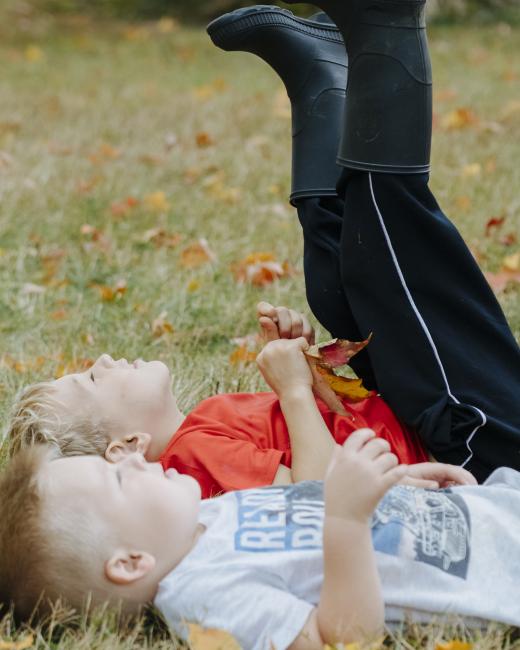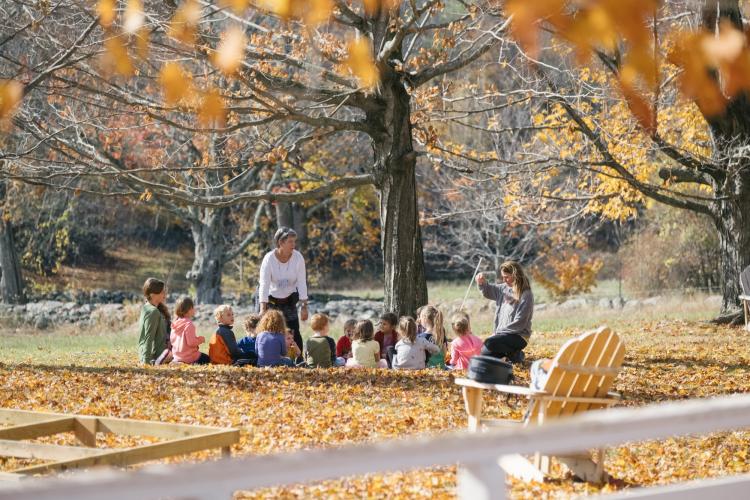School at Canterbury Shaker Village has an eye on the future and the past
With
financial support from Grappone Automotive Group and Toyota, the Dewey
School at Canterbury Shaker Village allows children to follow their
interests and take the lead in their learning. (Courtesy photos)
Jocelyn Neal is 5 years old. She can put paper into an old-fashioned typewriter and proudly type her name with ease. Her little sister, Jacey Neal, is 3 and can sit in front of a tank of tadpoles and identify all the stages of the frog’s life cycle, making sure to point out that tadpoles like their cucumbers without the peel. They both attend the Dewey School located at Canterbury Shaker Village in Canterbury.
The Dewey School is a nature-based Reggio-inspired early learning center for children ages 3-5.
Every day, the children are outside exploring some aspect of the nearly 700-acre property of Shaker Village that contains natural meadows, orchards, forests, ponds, streams, hills and trails. So far, the school only remained indoors for two full days because of high winds.
The Reggio Emilia approach originated in Italy after World War II and centralizes education around the children and their questions. “The children are the curriculum, so we follow their interests. There is no year-long calendar that we as teachers have created and follow,” said Mindy Beltramo, founding director and teacher at the Dewey School.
If the children want to learn about robots and machines, the teachers will be right there with them to answer their questions. Each topic sparks additional questions that lead to the next educational venture. Students were introduced to jazz music after reading “The Jazz Fly,” a book that Beltramo selected after the children became interested in the ticks and insects they were discovering outside. Students play in puddles to learn about empathy, build motor skills by manipulating washers and screws and gain an understanding of agriculture by watching the tomato seeds they potted grow.
Each
child has their own animal identity that was picked from a list of
species that live around the village. While they walk around outside,
they are able to see their animal selves interacting in nature. “Imagine
how excited the boy who is the blue heron was when he saw a blue heron
pick up and fly over us during snack time,” said Beltramo.
Grappone support
The
children spend the beginning of their day inside, engaging in
unstructured play of their choosing. The first floor of the school is an
art studio where children can express themselves through painting,
watercolors, clay and other freeform building. Upstairs, there are
activities centered on more cerebral skills. There is an engineering
station, a science table, a literacy area and creative fairy play area.
For about an hour and a half, the children are able to move
freely throughout the building and play anywhere they like. There are
mirrors hung around the classroom that allow children to build
self-actualization and see themselves as an artist, reader or scientist.
Jocelyn
and Jacey said their favorite activity at school is crafts. Other
children prefer to spend the majority of their time building.
“The
children can make certain choices and be interested in what they’re
doing. No one ever tells them they need to be done and move on,” said
Beltramo.
“Jocelyn
enjoys going to school every single day, and even on the weekends she
wants to go,” said Melissa Neal, mother of Jocelyn and Jacey. “There’s
so many hands-on opportunities, and that’s really what drove us to come
here,” Neal said.
Since
enrolling her children at the Dewey School, Neal has noticed Jocelyn
taking more initiative around outdoor activities. She encourages her
family to go on walks outside and demonstrates more creative and
out-of-the-box thinking.
The
school, which opened last year, is named after the previous Shaker
resident’s dog, Dewey. The school currently hosts 19 students. Next
year, the school plans to nearly double in size to accommodate 40
students throughout the week.
The
school could not have started without funding from Grappone Automotive
Group, based in Bow, and automaker Toyota, which has a program that
matches charitable donations made by affiliate dealerships, allowing
Grappone to double the funds provided to the school.
Unlike other grantors, Toyota allows the school to use the money for operational expenses, such as teacher salaries and utility bills.
“The
money from Toyota is the only reason we were able to pay our teachers
during Covid-19,” said Amanda Grappone Osmer, director of corporate
potential for her family’s company and chair of the board of the Dewey
School. She explained how most schools experience a “funding gap,” when
tuition does not fully cover finances. Money from groups like Grappone
Automotive ensures that the Dewey School can remain fully operational.

Grappone
Automotive is a family-owned company that has been around for four
generations. Grappone Osmer’s great-grandfather originally opened up a
gas station in 1924 and started selling automobiles in 1925. The company
today consists of five franchises and about 330 employees.
Grappone
Osmer said it is part of the company’s mission to “serve our team
members, guests and community with integrity, kindness and respect.” The
company donates a minimum of 5% of its net profits to charities and
other nonprofits. “Supporting the community is just part of who we are,
and growing up, I didn’t know there was any other way,” said Grappone
Osmer.
Dream school
Grappone
Osmer’s involvement with the Dewey School expands beyond the charitable
giving she initiates through Grappone Automotive. She helped found the
school after unexpectedly striking up a conversation with Beltramo at a
mutual friend’s birthday party at Shaker Village.
“Amanda
looks for employees who are problemsolvers and creative thinkers —
skills that are developed from the very beginning, and she wanted to
fund a good foundation,” said Beltramo.
Beltramo
spent her entire career working across the country in educational
settings that ranged from early learning to sixth grade. After spending
years in public education, she started taking master’s level courses in
natured-based education and Reggio Emilia through Lesley University and
Antioch University, respectively. “My experience in public education led
me to work on my master’s, because I knew something had to change
drastically. There had to be something more.”
It
was during her studies that she started to articulate what her dream
school, which would combine both of the educational styles she was
studying, would look like. “It wasn’t an assignment, but I just needed
to get it down on paper,” said Beltramo.

Grappone Osmer supported Beltramo’s vision and after that serendipitous lunch, they worked together to make it a reality.
Grappone Osmer serves as a “healthy conduit between the Dewey school
and Shaker Village.” Currently, she is the Dewey board’s chair and is a
former trustee and now a member of the board of corporators of Shaker
Village, the school’s location. Grappone Osmer is a longtime supporter
of Shaker Village and always had an interest in education. “You don’t
think of a car dealership and a preschool as being common buddies, but
why not? I think our different perspectives have really allowed us to
think creatively,” she said.
When
she saw the opportunity to start a school advantageous to children’s
critical brain development, she urgently worked to bring that idea to
fruition. “For me, it is personal, almost like a responsibility because
there is a better way for kids to be,” said Grappone Osmer.
Supporting Shaker Village
Grappone
Osmer also hopes the school will contribute to the longevity of Shaker
Village, a nonprofit museum dedicated to preserving the 200-year history
of the Canterbury Shakers.
The
village is a National Historic Landmark for its architecture and
overall significance. The museum, which consists of 25 restored
buildings, four reconstructed buildings and 694 acres of land, preserves
and shares the legacy of the Shakers, a religious group that descended
from English Quakers and Methodists who practiced a celibate and
communal utopian lifestyle as well as equality of the sexes. Their
architecture, technological innovations, music and furniture remain
important influences today.
The life of the Shakers is incorporated into the Dewey School’s activities.
“We
talk about the people that live here as much as possible,” said
Beltramo, adding that the school aligns with the original ideals of the
Canterbury Shakers.

“They
were this alternative community in a very conservative and rural area,
and in a lot of ways we are providing similar alternative educational
options in a world of classic day cares.”
Like
many museums, the Shaker Village has experienced a decrease in the
number of visitors it has attracted over the years, so it is looking for
ways to stay viable and remain of interest to the general community.
Grappone Osmer believes the Dewey School helps Shaker Village do just
that. “We’re getting a lot more people to come to the village and have
an emotional attachment to it who never would have otherwise,” she said.
Both
Beltramo and Grappone Osmer hope the Dewey School will spark a lifelong
connection to the village and will motivate the children to preserve it
in the future.
“We’re
starting to plant the seeds,” said Grappone Osmer, who sees the school
as a model for how museums can creatively operate over the long term.

‘The children can make certain choices and be
interested in what they’re doing. No one ever tells them they need to be
done and move on.’